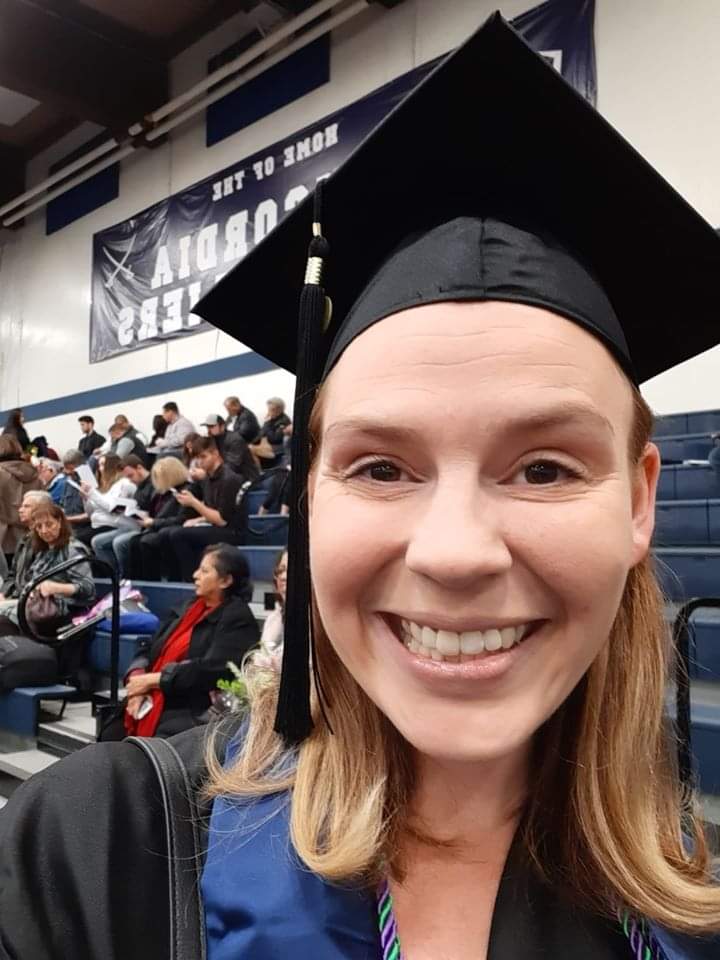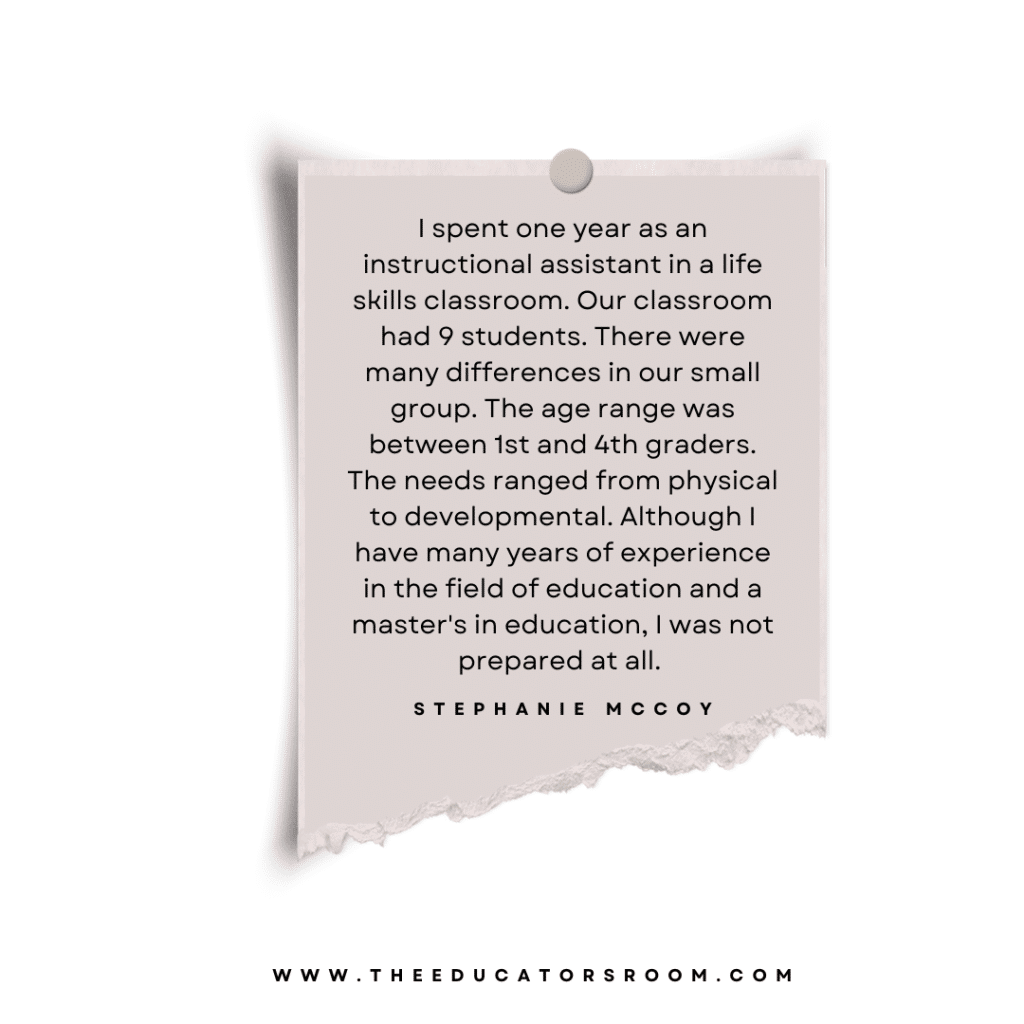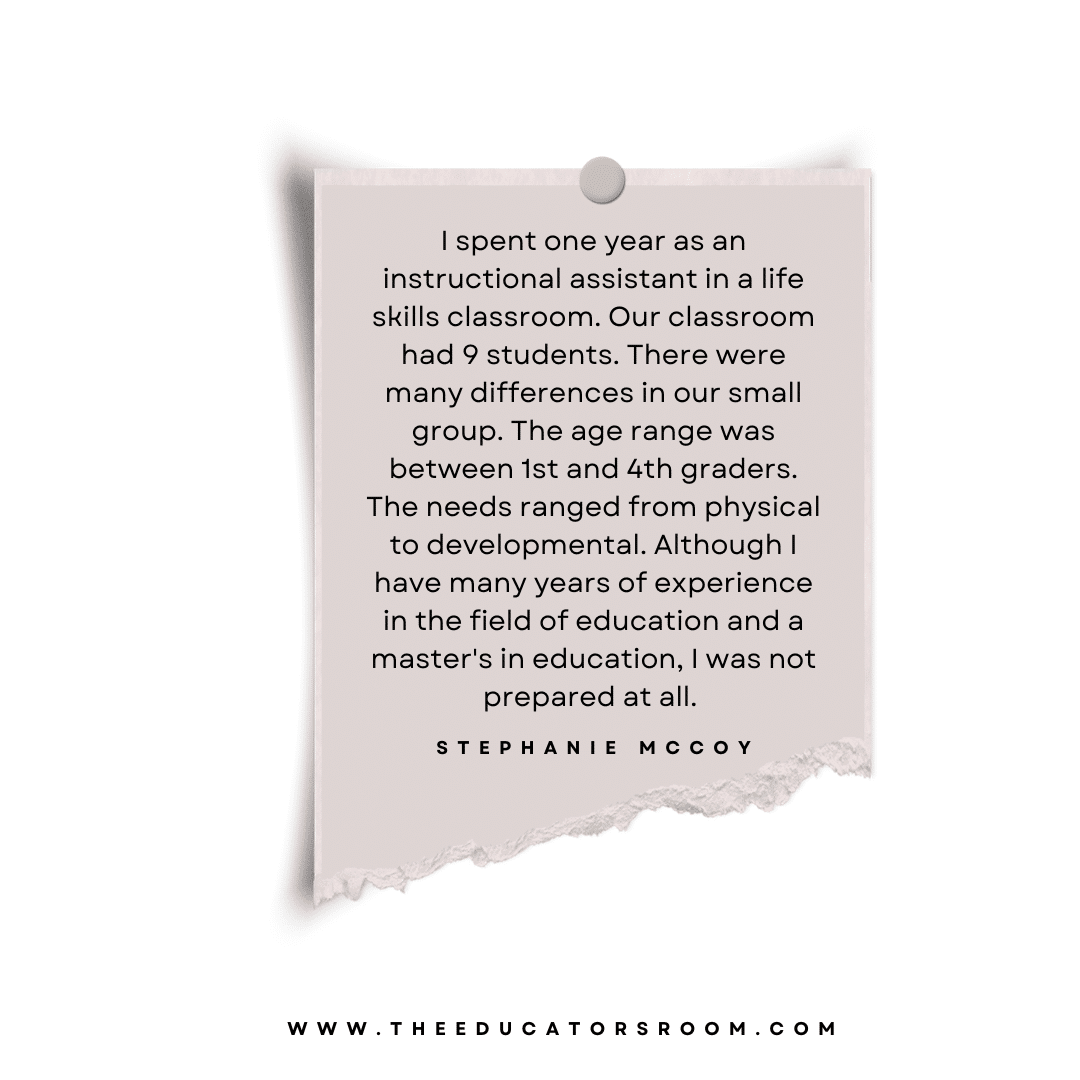I spent one year as an instructional assistant in a life skills classroom. Our classroom had 9 students. There were many differences in our small group. The age range was between 1st and 4th graders. The needs ranged from physical to developmental. Although I have many years of experience in the field of education and a master’s in education, I was not prepared at all.
General Education v. Special Education
Similar to a general education classroom, each student in a special education classroom has a preferred learning style. It also should be considered that some special needs students have physical disabilities that take the option for certain learning preferences away. For example, one of our students was blind. Visual learning was not an option for her. Another student had spinal bifida, so he was limited in his ability to participate in physical activities as he could only use one hand.
In general education, lessons are generally designed according to average grade-level math and reading comprehension scores. The lessons, in a perfect world, will be understood by most students at that grade level. Of course, there will be students who do not understand the material.
In special education, because of grade level differences and disability differences, the educational offerings need to be even more customized. A teacher cannot simply come into a special needs classroom and start teaching a standard lesson for everyone. There are a variety of goals and abilities.
Customized Education Plan
The idea of customized education in life skills really hit home when I heard one specific request from a parent last year. We had told her that we were working with her son on how to write his name. She said to us, clearly exasperated, “I appreciate what you’re doing, I really do. But I don’t care if he ever writes his name. He probably won’t, and that’s okay with me. You know what I’d love for you guys to teach him. What a stop sign looks like in case he ever gets outside without me knowing. I want him to know what street signs look like…”
That request really put things into place for me as an educator. We shouldn’t be trying to teach some of these kiddos typical school subjects like reading and math because their futures will be atypical. It’s very likely that some of these students will grow up with caregivers and assistance their whole lives. The caregivers will be taking care of typical things like bill-paying and tasks that require reading, writing, and math. With that said, there are some students in the load who are capable of working on typical subjects.
One of our students would burn through several worksheets in just minutes. We would have to print out a huge variety of worksheets every night for him to do the next day. He was our 1st grader. The oldest student in our class, a 4th grader, couldn’t identify even one letter.
Adjusting Timing of Lessons
As educators, we were able to identify when the best times were for our students to meet their goals. For some kids, it was at the beginning of the school day. For other students, it was after lunch. Then for others, it was during recess. We had the advantage of knowing when, where, and how they were ready to receive information and attempt a task.
Timing is important, but the environment is also crucial to a student’s success. Just like in general education, special education students have preferences in their learning environment. Some appreciate the quiet while others can learn in the middle of a football field. To help with this, we kept tools around that could alter their environment. A simple cardboard divider on a desktop could act as a barrier to noise and outside stimuli. We also embraced fidget toys for students who needed to keep their hands busy while concentrating on a mental task. Noise cancelling headphones were also a lifesaver in our classroom.
The Beauty of the IEP
When it comes to tailoring education to each child in a special needs classroom, educators have one priceless tool: an IEP. An IEP, an Individualized Education Program, states the educational needs and goals of those with disabilities. An IEP is updated each year. What I learned throughout my experience is that although an IEP is technically updated each school year, teachers are able to monitor growth and update goals as often as needed. I had an incredible head teacher, and she encouraged us to make observations each day and update goals as students met them. We were constantly crafting materials and worksheets to give our students the opportunity to meet their goals.
I know firsthand the work that goes into monitoring IEPs. Our head teacher and all three of us assistants were constantly observing and recording achievements and failed attempts. Progress was tracked and new goals were set. I did notice though that working toward IEP goals and IEP goals alone left out the opportunity to prompt other ways for our students to grow.
IEP Goals
Small actions or interactions should be noted as successes too, even if they aren’t listed as IEP goals. Taking instructions from a teacher or peer, picking up a toy that fell on the floor, or grabbing shoes from their cubby were all counted as huge wins in our classroom. Further, things that seem miniscule like not throwing a toy in anger when it’s time to clean up could be a monumental success to some students. If a student is successful in tasks that aren’t listed on their IEP, educators should document it and discuss setting possible goals in that area the following school year if it is something that is deemed valuable by their caregivers and support.
Social skills are also important skills that don’t seem to be featured in too many IEPs in my experience. It can be a huge goal like engaging in cooperative play with another student or a small act like sitting side-by-side playing with another student or teacher.
A few of our students were able to have exposure time to general education students. One of our kiddos was able to attend lunch in the cafeteria with 2nd graders in general education. They absolutely loved having him there and he loved being there. He looked forward to it every day and would continually watch the clock and watch for my cues that it was time to go. Our other students would receive visits in the classroom from peer helpers. The peer helpers were students from gen-ed who were deemed responsible enough to visit our classroom. Some of our students would happily engage with them, some would shy away, and the rest wouldn’t really acknowledge them.
Enhancing the Experience
A multitude of factors should be considered when trying to enhance the experience of a student with special needs: communicating with their parents and caregivers, following their IEP goals, providing opportunities for achievements outside of IEP goals, giving opportunities for social skills if applicable, providing a comfortable environment, providing learning aids, and continual research on the disabilities of the students in the classroom. To build an optimal learning environment, there are some great resources out there.
To build a thorough IEP, I would highly recommend this article. The article features around 1,000 ideas for IEP goals. The ideas are sorted by categories such as behavior, focus and attention, academics, and anxiety goals. They are also sorted by disability type such as autism. The U.S. Department of Education website is also a good place to start. They provide sample IEPs and break down the important pieces of information.
Social Skills
For parents and caregivers who want to put focus on building their child’s social skills, there are some good support groups and even apps that can provide opportunities to work on those skills. The groups and apps take into consideration different developmental disabilities such as autism, ADHD, etc. Finding groups locally may also be a good way to go. Groups like Meetup aim to provide support and friendship opportunities for certain groups of people, such as kiddos with special needs. Parents and caregivers may also find a sense of camaraderie by reaching out to other parents in their child’s classroom if appropriate. Although some children may not interact well together, some may be able to build a friendship outside of school with their peers.
To seek out and provide goals that are presented through new research, teachers, and caregivers should follow sites such as Education Week and The Journal of Special Education. Parents and caregivers can also benefit by asking their child’s doctors, physical therapists, and psychologists about new techniques, medications, and practices that may help their child to be more successful and comfortable.
Conclusion
If my experience taught me anything about life skills/special education classrooms, it’s that this sector of education has a huge breadth of support. Physical therapists, behavior specialists, speech pathologists, audiologists, and occupational therapists are just some of the specialists. I am so grateful that it seems there is a specialist for nearly every type of special need that a student may have. My hope is that students with limitations will be provided continual opportunities for growth in a number of areas. Special needs, like general education, is certainly not “one size fits all”.

Stephanie McCoy is a mother of two and an educator from Portland, Oregon. She recently earned a Master’s degree in Education with a focus on educational leadership. She is passionate about equity, privilege, and everything in between.




